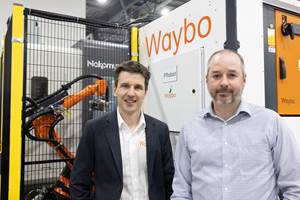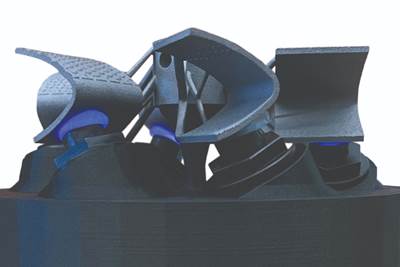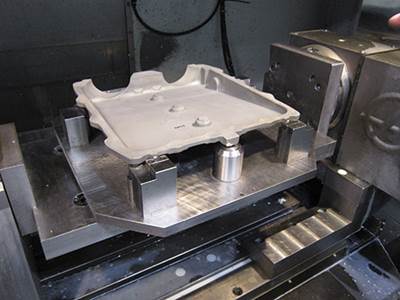Share






As metals go, aluminum is soft and quick to bend — factors which make it easy to work with for most machining applications but make workholding to tolerances of 0.0005 inch unfeasible with traditional grippers. The force required to perform workholding could send the part out of tolerance, requiring rework or scrap. For Thomas/Euclid Industries, this difficulty became the push it needed to experiment with alternative forms of workholding, utilizing Blue Photon’s adhesive grippers to perform contactless gripping on an EV strut housing made from an aluminum casting.
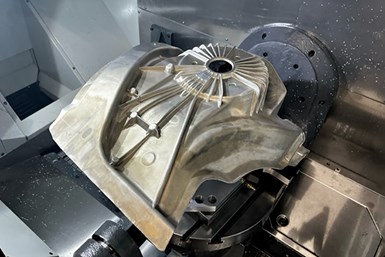
Soft material was not the EV strut housing’s only workholding challenge: The part barely fit the UMC 750’s travels. Potential fixtures needed to be low-profile enough to ensure the part continued to fit the machine. Images courtesy of Thomas/Euclid.
Maximizing Lights-on Profits
Thomas/Euclid is primarily an aerospace manufacturer — EV automotive parts are not the norm for the company. In this case, the job came about not long after the shop installed a Matsuura MX 330 five-axis machine. The new machine’s automation capacity enabled the shop to run many of the jobs previously on its five-axis Haas UMC 750 for longer periods, decreasing the time necessary to complete these jobs even as it left the UMC 750 idle. Ryan Merrill, chief operating officer at Thomas/Euclid, says the search for additional work to put on the shop’s UMC 750 led the company to a customer already committed to machining EV strut housings.
Complications had arisen from the compressed timeframe to prepare for the job — the typical two-year development time for the part had been shortened to eight months — and a delay in receiving the five-axis machines the customer had been planning to use to machine the housings. Thomas/Euclid had the opportunity to act as a stopgap, delivering parts until its customer’s machines were up and running.
Another complication? Most shops that had been offered the job had already turned it down due to the nature of the part itself: a 20-inch-long, near-net aluminum casting with an odd shape and inconvenient tolerances. While the customer would provide the casting, and all Thomas/Euclid needed to do was machine holes in it, consistently gripping the part without marring and distorting it was a massive challenge.
The combination of a quick-change base and adhesive workholding enabled the shop to manually change over setups and fixture parts in about seven to 10 minutes while achieving a repeatability that other workholding methods could not match.
Getting the Green Light on Blue Photon
Adhesive workholding offered a path forward, but not one Thomas/Euclid had used before. While the company had looked at Blue Photon’s adhesive grippers for several applications, the shop had always decided against using them due to the technology’s startup costs. With the EV strut job requiring a contactless workholding setup, however, Thomas/Euclid’s programmers and engineers were quick to point out that adhesive workholding was the most viable method for handling the job.
Properly attaching the Blue Photon grippers to the part required irregularly shaped fixtures for each of the four variants of the part (two operations, each with a left- and right-hand version). Blue Photon’s applications engineers volunteered to help, designing the fixtures for additive manufacturing and printing them through Stratasys. Thomas/Euclid then bolted the fixtures onto a quick-change Jergens-type base and screwed the Blue Photon grippers into the ends of the fixture.
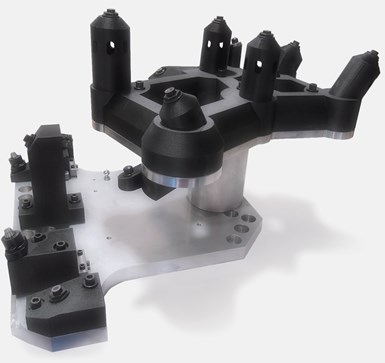
The EV strut housing was the first project for which Thomas/Euclid used 3D printed fixturing. While the experience involved some growing pains, with the fixture coming in heavier than expected, the shop was able to prove out all four versions in time to produce the part.
Shining a Light on Adhesive Workholding
After applying dime-sized dollops of the BlueGrip adhesive to the grippers, Thomas/Euclid’s machinists set the workpiece on the fixture and slid an ultraviolet light up from underneath. This light is connected to a magnetic rod, which snaps into place at the back of the gripper. After about a minute, the adhesive locks the part into place.
From here, the company was able to machine the part with no issues. Removing the part required loosening the grippers with a normal socket wrench, then using a handheld steamer to remove the residue from the Blue Photon grippers.
Hands-On At All Times
Due to the short run of the part, the shop was not able to automate this last step and therefore manually fixtured parts and changed over setups. Still, the combination of a quick-change base and adhesive workholding enabled the shop to perform these changeovers in about seven to 10 minutes while achieving a repeatability that other workholding methods could not match.
Thomas/Euclid has handed off the EV strut housing job to the original customer, but maintains its Blue Photon stock for suitable future projects.
“It was the first time our customer had ever worked with us. It was the first time we had ever worked with Blue Photon. We put a lot of trust and faith in each other that we were going to pull it off, and there were of course some road bumps along the way, but we pulled it off,” Merrill says. “It was incredibly impressive how well Blue Photon worked on this project.”
Related Content
Machining Vektek Hydraulic Swing Clamp Bodies Using Royal Products Collet Fixtures
A study in repeatable and flexible workholding by one OEM for another.
Read MoreShop Doubles Sales with High-Mix, Low-Volume Automation
Robots with adaptive grippers have opened entire shifts of capacity to high-mix, low-volume shop Précinov, doubling its sales.
Read MoreParts and Programs: Setup for Success
Tips for program and work setups that can simplify adjustments and troubleshooting.
Read MoreNavigating Large-Scale CNC Machining: Suburban Tool’s Niche Strategy to Stay Competitive
Facing increasing competition from lower-cost imports, Suburban Tool made a move toward large-scale, in-house machining. By identifying a niche in large, precision angle plates and tombstones, the company has strengthened its ability to control quality and protect its reputation.
Read MoreRead Next
Temperature-Activated Adhesive Overcomes Limits of Magnetic and Vacuum Workholding
This new chemistry-based solution for five-sided machining allows for a diversity of metals and other workpiece materials to be used along with aggressive cutting forces.
Read MoreChoosing Workholding to Meet Machining Challenges
When it comes to workholding, shops can choose from options that can provide flexibility, help increase throughput and enable five-axis machining.
Read MoreShop Finds Fixturing Solution for Flexing Parts
Precision Grinding and Manufacturing uses an atypical means to fixture thin parts that are prone to flexing when conventional workholding clamps are used: adhesive cured by UV light.
Read More



































.jpg;maxWidth=300;quality=90)






